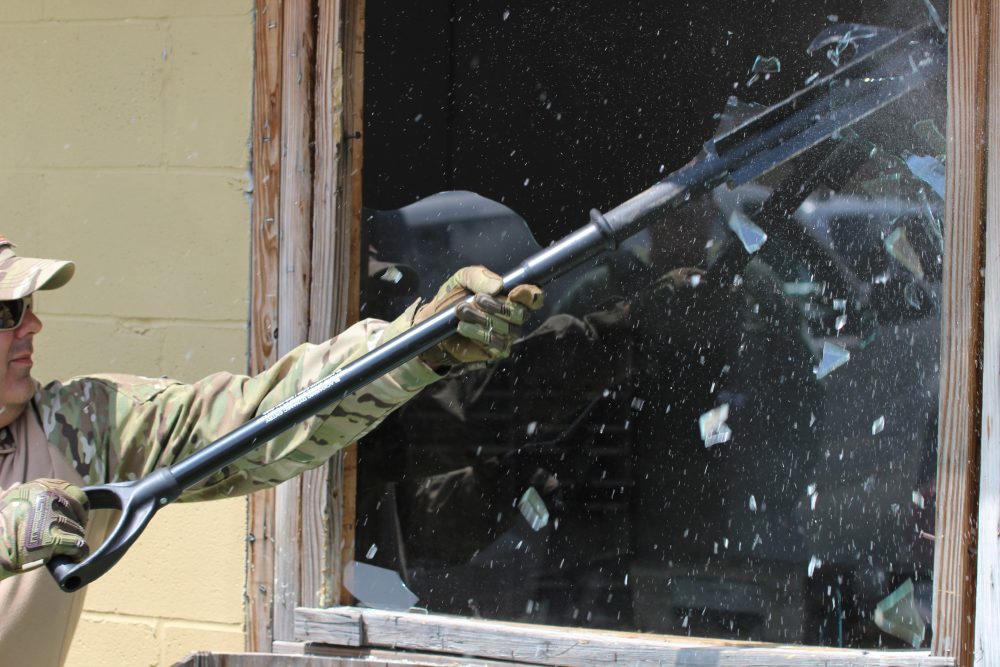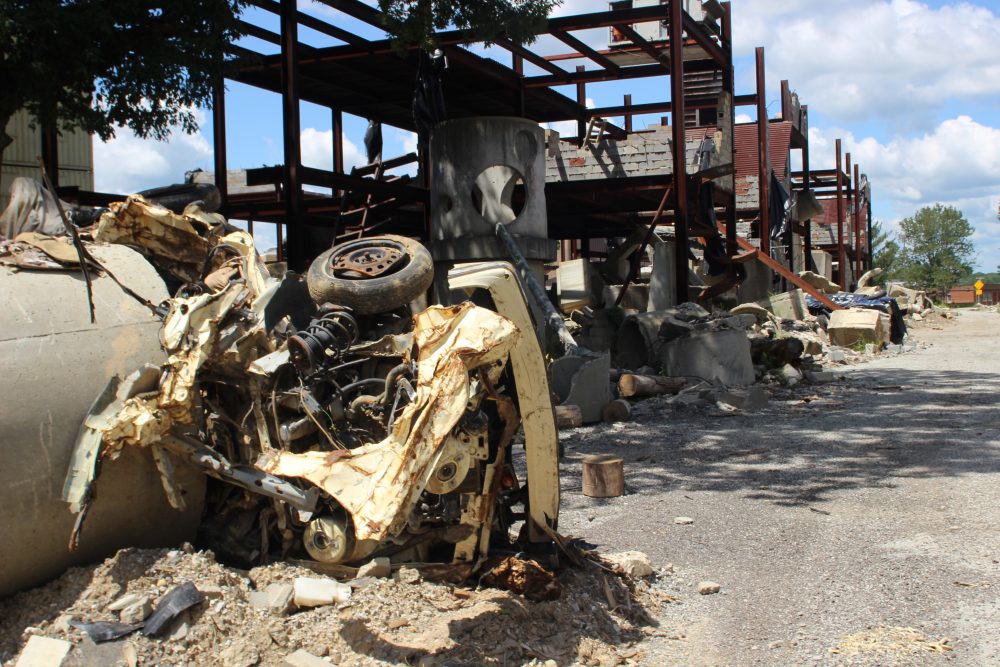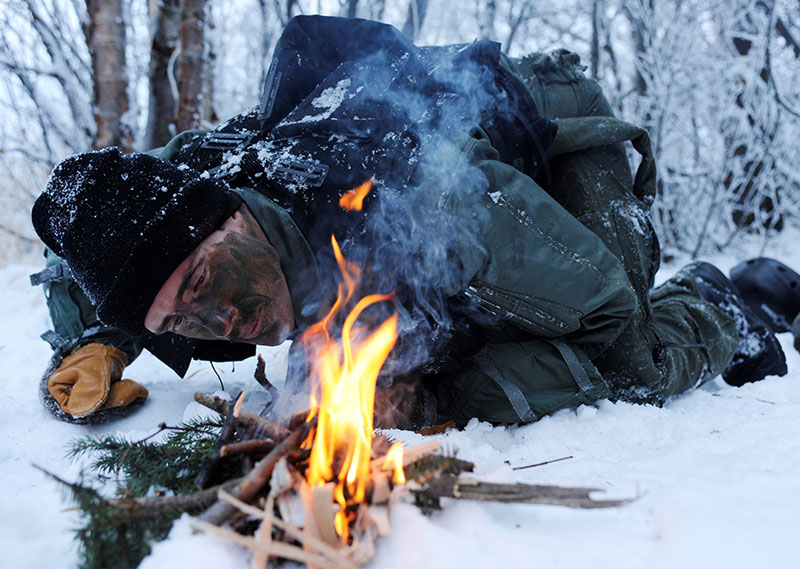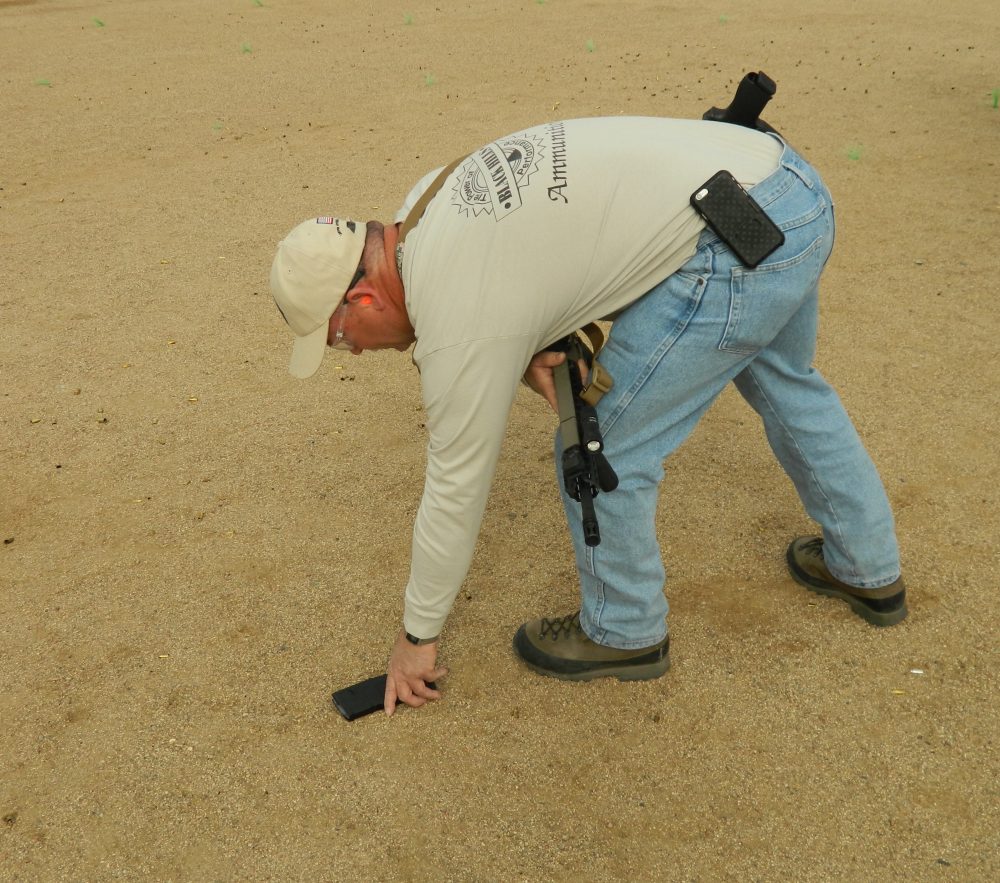Student practices “break and rake.”
The days of handing Mongo a battering ram and commanding him to “Open that door” are over, at least if Bryan Hillis has any say in the matter.
For a majority of police and military units, forced entry and door breaching during tactical operations have long been afterthoughts. Too often they are considered pregame warm-ups for the main event: the actual entry into a structure to neutralize bad guys and rescue hostages.
This is why the typical operation starts with the largest and/or most aggressive operator in the team being handed various implements of destruction and told to remove doors and windows so the “real” work can get underway.
This approach works often enough that it continues to be the norm. However, as bad guys get more sophisticated and liability concerns grow even greater, the entire process of making quick forced entry needs to be approached with the same amount of preparation, planning, and training as other facets of an operation.
Bryan Hillis talks to class inside one of breaching simulation houses at Muscatatuck Urban Training Center.
Table of Contents
BREACHING ATTITUDE ADJUSTMENT
That idea is what Hillis, President and CEO of Alexander Global Strategies, sees as his mission. “Everything we do,” said Hillis, “is trying to change the way teams, team commanders, and administrators deploy and use breaching. So often, it’s the newest guy or strongest guy—we need to change that philosophy. This is a specialized skill within your unit and it should be treated as such.
“You can’t just give a ram to a guy and tell him ‘figure it out,’ ” he continued. “This is a high-liability area. You’re talking about destroying somebody else’s property, and so many times it’s not thought about in that way. We’re trying to reshape that.”
To that end, Hillis and his company, Alexander Global Solutions, have created a Three-Day Manual, Mechanical, Ballistic, and Thermal Breaching Course that is taught primarily at the Muscatatuck Urban Training Center (MUTC) in rural southeastern Indiana, tucked among rolling hills approximately halfway between Indianapolis and Cincinnati.
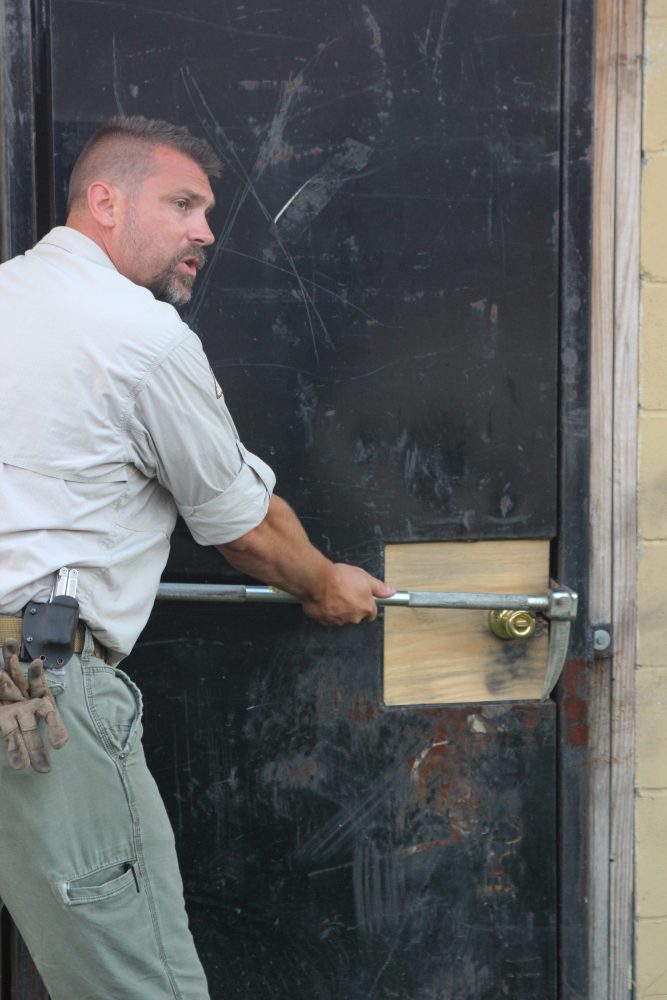
The facility, operated by the Indiana National Guard, is one of the most unique in the country and, coupled with Hillis’ course, offers a world-class forced-entry training opportunity.
TRAINING CREDENTIALS
Hillis is a 15-year veteran police officer from northern Indiana and has an impressive resume. An instructor in various disciplines for 20 years, he is a long-time member of his agency’s SWAT team and also did a stint as a contractor for the U.S. Diplomatic Security Service.
Among other things, he spent time in the Middle East as part of a U.S. cadre training a national Presidential Protective Detail in various anti-terrorism skills. He has also provided executive protection services for many high-net-worth individuals and at least one A-list show business personality.
But aside from his resume and experience, what sets Hillis apart from many other qualified instructors in the training industry is his devotion to the fine art and science of breaching.
“I’ve attended a handful of schools [that touched on forced entry], but in 2002 I took a dedicated breaching class and kinda got bitten by the bug,” Hillis said. “Things in that course just resonated with me and it’s continued from there.”
But Hillis has realized that forced-entry training isn’t nearly as popular or deemed as important as the sexier aspects of tactical operations, such as entry techniques or shooting. “What we’re finding is that industry-wide, it [breaching training] seems to be the biggest afterthought,” he said.
Training with quickie saw, student slices through reinforced concrete.
IDEAL TRAINING CENTER
In response, Hillis created the breaching course. Then, when looking for a place to conduct training, he realized MUTC offered the ideal classroom.
The training center started out in 1919 as the Indiana Farm Colony for
Feeble Minded Youth. The name eventually was changed to the more palatable Muscatatuck State Developmental Center and was Indiana’s largest mental hospital, housing over 3,000 patients. For various reasons, the center was closed in 2001.
Once the facility closed, the state found itself holding a 1,000-acre fenced compound containing hundreds of buildings that required daily maintenance and was located in a very rural portion of the state, limiting possible re-use options.

Fortunately, an ambitious plan was developed and the facility was turned over to the National Guard to build MUTC. The purpose of the facility is to train civilian first responders in disaster response, while the military uses the area to practice urban warfare, especially units preparing for deployment overseas.
In real terms, the mission includes a variety of groups and activities. At the same time as the breaching class was in session, FBI evidence response team members were training on evidence collection throughout the compound, and U.S. Marines were seen challenging robed “insurgents” during urban clearing operations.
Not only are there hundreds of buildings and tunnels, but the U.S. government has built the most extensive and realistic post-apocalyptic urban landscape imaginable. There are hundreds of destroyed vehicles across the property alongside single-family dwellings, gas stations, churches, and other buildings in various stages of pseudo-destruction. Several parking garages were actually built in a collapsed state.
In addition, a junkyard, farm, motor pool, embassy, full-size prison, and a variety of other specialized buildings were erected specifically for tactical training. And if that weren’t enough, the site includes a wrecked airliner, an actual flooded neighborhood, and a wrecked passenger train that resulted from a “washed-out” bridge.
Best of all from a breaching standpoint, many of these items can be cut, smashed, and bashed at will. In fact, a full neighborhood of houses are set up with reusable breaching doors and windows made with frames for quick replacement of glass panes.
“This facility is great,” Hillis said. “We treat this as a living, breathing laboratory. Bring all of your stuff. Now is the time to try it and then stand back to say, ‘If I did this, what happened?’ We put problems in front of students and have them solve those problems with their own issued tools in hand.”
Sparks fly as student slices through steel debris with thermal torch.
BREACHING CLASS
Training Day One of the class covers mechanical breaching, safety and general concepts. Students learn basic and advanced techniques for using brute force correctly to open structures, with a focus on proper physical mechanics and intelligence gathering. Total classroom time is held to a bare minimum.
Day Two covers ballistic breaching, i.e., using the shotgun to break open doors and locks. Students use their own weapons and rounds to work through various scenarios in both the indoor simulators and the breaching neighborhood.
The training day is long, with students collapsing in their bunks close to 2300 hours. But a primary goal is to afford extensive low-light practice in both manual and ballistic breaching. Many students commented that even those with prior formal training had never been allowed to spend hours practicing the skills at night, even though many breaches occur in darkness.
Students get to experience a variety of situations including multiple manual and shotgun breaches on a variety of doors, plenty of shattered window glass during “break and rake” sessions, shooting car doors, and even learning to penetrate chain-link fence in a quick and efficient manner.
Bryan Hillis instructs student while practicing with thermal torch.
SAW AND THERMAL BREACHING
The final training day covers the “Quickie” K760 Rescue Saw and Broco Thermal Lance. Hillis likes both tools because they are widely available. Every fire truck in the U.S. has a quickie saw, and many departments also have a thermal lance or its equivalent.
“I think it’s important because it’s readily accessible. If you go to the local firehouse, they have it. Then, when a situation is life-threatening, it’s important that you know how to grab that stuff and deploy it,” he said.
While thermal and saw breaching are only needed in certain specialized instances—breaching windows with security bars or entering a heavily fortified building such as a jail—these skills round out the abilities of a team.
“It has its place,” Hillis said. “A guy can go 15 years and never use it, but you might leave here tomorrow and grab it off the truck. If you narrow it down and only give yourself two or three methods of entry, you’re not doing yourself justice. The word ‘toolbox’ is overused, but you need to have many things you can grab, use and deploy with confidence so you have other options.”
While both the saw and lance seem straightforward, students quickly found there is a learning curve for even these relatively uncomplicated tools. Fortunately, along with static practice stations provided by the instructor, throughout the facility a plethora of junk exists to practice cutting.
The thermal lance is simplicity itself: a hollow metal tube with pure oxygen fed through the center and ignited via a battery, creating a burning metal jet that cuts through steel quickly and with relatively little noise.
In use, students learned a subtle “touch” is necessary to keep the cut moving quickly and prevent a shower of 4,000-degree liquid metal from hitting the operator. But the site has no shortage of steel structures to practice on, so each student gets nearly as much torch time as he desires.
Though it appears to be a post-apocalyptic landscape minus zombies, this is actually one purpose-built street inside MUTC.
STUDENT FEEDBACK
New SWAT operator Steve Linville of Dayton, Kentucky was impressed with the course, the facilities and Hillis. “Quality of instruction is great. It’s very laid back. I’ve found just in my limited time on the job a more laid-back approach gets better reception from people. It’s easier to learn that way.
“I’m a lot more comfortable with breaching, especially with the manual breaching with the ram. They really broke it down here in terms of body mechanics. I’m the smallest guy on the team and it may take me more hits than another guy, but with the mechanics I’ve learned, I won’t get nearly as exhausted,” he added.
Detective Shawn Hines from the Bloomington, Indiana Police Department liked the “real world” conditions. “I think it’s fine to sit in a classroom and talk about it, but to get out into the field in a laboratory situation and get hands-on is great,” he said.
He also had high marks for Hillis. “I think one of the unique things about this course is the instructor. He makes himself readily available at night, so once the class is stopped, it’s not over yet. He’s still there to bounce ideas off of,” Hines said.
“We don’t train until 4 o’clock and call it a day,” Hillis said in response. “Our philosophy is that we try to exceed the standards and confirm that guys comprehend what we’re trying to accomplish. We don’t train to time, we train to comprehension,” he continued.
Ultimately, Hillis is doing his best to change how SWAT teams and military units approach forced entry. “Nowadays, everybody is so enamored with handgun and carbine courses. We’re trying to reshape the mindset of the younger SWAT officers. We really want them to know how important this [breaching] is. You can’t go and do all that cool-guy stuff unless you get inside first,” he noted.
In that regard, three days spent at one of the most unique training sites in America during the Manual, Mechanical, Ballistic and Thermal Breaching Course will leave any operator much better prepared to clear the way—even when Mongo isn’t available.
SOURCE
Alexander Global Strategies
(844) 247-7475
www.alexandergs.com
